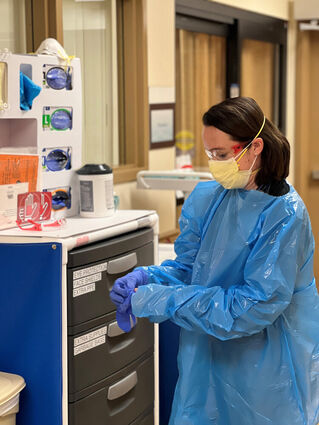CFVH continues to adapt to pandemic
December 9, 2021

Courtesy photo
SUITING UP - Dr. Jessica Valentine puts on personal protection equipment at Clark Fork Valley Hospital.
After facing over a year of pandemic, Clark Fork Valley Hospital (CFVH) has had to make a few changes to keep things flowing and to keep up with an ever-changing hospital environment. Some of these changes included the way the hospital intakes patients and improves their rooms to accommodate for COVID-19 patients, new medical equipment and even a COVID-19 nurse hotline.
One change the hospital has faced is trying to funnel people into different areas. The building has been constricted to only a few entrances and exits. Certain areas of the hospital have been quarantined for patients with COVID-19 to be kept separate from the rest of the hospital population. These include two emergency rooms (ER) specifically for COVID-19 patients.
Barry Fowler, CFVH Director of Human and System Services, said Sanders County is the fourth oldest county in the state by median age, and explained the particular risk posed to many community members. Fowler oversees many of the support departments in the hospital and has been in charge of altering many of the rooms and the layout of the hospital. According to Fowler, most hospitals have only two negative pressure rooms, meaning that the room keeps air from leaving the space. CFVH had one room prior to the pandemic and has had to find innovative ways to create more. The hospital now has eight negative pressure rooms for COVID-19 patients. They have also had to "create opportunities for there to be barriers between people while also allowing the ability to communicate. We've had to be very creative with that," said Fowler.

"In the last few months there has been an uptick in frustration" in patients, said Chief Nursing Officer Lisa Eberhardt. "We're very lucky to have a healthcare facility of this quality in a community this size." According to Danita Grossberg, registered nurse and Acute Care Manager, the hospital uses contact isolation, which limits the number of people who encounter an infected person. Grossberg also explained that a COVID-19 patient requires more time, not just in treatment, but also in time required by the nurse to put on proper personal protection (PPE). On top of that, nurses now must do everything to further avoid unnecessary contact between a COVID-19 patient and others. This means the same nurse will need to clean the room and bring food to the patient on top of his or her traditional duties.
The nurses say that COVID-19 patients are not the only ones whose treatment has changed, post pandemic. It has now become difficult to treat non-COVID-19 critical patients. Eberhardt explained, "It has changed the whole dynamic of the care that we provide." Before the pandemic, they transferred patients in need of more urgent care to better equipped facilities, but with most other hospitals full and assets stretched thin, CFVH has had to treat these patients in-house. "In addition to COVID, we still have all our other regular patients," said Grossberg. They often need to adjust hour-to-hour to make everything flow properly and to get patients treated in a timely manner. According to CFVH President and CEO Dr. Gregory Hanson, the situation is always dynamic, and they are always changing the process to assess patient needs. "That in and of itself is stressful," said Hanson. He explained that even though COVID-19 interest has seemed to drop down, hospitals remain full of patients with conditions other than COVID-19. No one is sure why there seems to be more patients now than before the pandemic, but Hanson believes it could be due to patient treatment backups or patients having waited to seek treatment until after the pandemic had subsided. "It is not just COVID patients, this affects regular patients," said CFVH Hospitalist/ED/Obstetrical Care Provider Dr. Jessica Valentine.
Valentine and Eberhardt explained the variety of ways patients get admitted with COVID-19, primarily through the ER or the clinic. Whether or not they are admitted for COVID-19 depends on symptom severity. Fortunately, nurses Eberhardt and Grossberg explained that most cases have mild to moderate symptoms. These people are sent home to recover.
One of the most common ways the hospital discovers positive cases of COVID-19 is through patients who come to the clinic with a respiratory illness. Very ill patients with COVID may need to be put on oxygen, though the hospital has been experiencing a shortage. Treatment is different for every person, and most of what the hospital does is supportive care. The hospital can also give Dexamethasone to patients with low oxygen levels, and CFVH recently added four high-flow oxygen machines. Before the pandemic, they had machines that could only administer 15 liters of oxygen per minute. The new machines can administer 40 liters per minute. These new machines also help doctors avoid using intubation.
For patients who have COVID-19, Valentine suggests getting an over-the-counter oxygen saturation monitor. If a person registers low, they should be seen by a doctor. Valentine recommended that any oxygen level below 90% can be considered low. She also suggested using body positioning to help ease breathing. Valentine explained that in COVID-19 cases, the hospital mostly treats the complications that arise from the disease.
When asked when a patient should seek medical help, Eberhardt said that every person reacts uniquely to COVID. CFVH staff suggested seeking help at the hospital if a patient is experiencing chest pain or becomes tired after moving from one room to another. However, the first thing Valentine suggested was for patients to minimize exposure to other people. Valentine then recommended following the basics: increase fluids, eat, rest, get up and move around a little, and get oxygen if needed. Valentine explained that anything one would do for a flu can help with COVID-19. She included over-the-counter medications such as flu medicine for stuffiness and cough, or Tylenol for pain, etc.
The hospital will also use Remdesivir, an antiviral medication, and will administer Regeneron, a monoclonal antibody treatment. The latter is administered through an IV and is even given to patients with early and mild symptoms of COVID-19.
According to Hanson, there is no specific instruction from the administration on treatment. "We have a very diverse and talented group of people that work here," he noted. "We've had staff stand up every time it was needed. That is the biggest thing that we try to celebrate."
The hospital vaccinates anywhere from 60 to 100 people per day for COVID-19. One day they did as many as 800 people in eight hours. Fowler said that day said a lot about the quality of the care providers at CFVH.
To date, the hospital has conducted over 7,057 COVID-19 tests and given almost 6,000 vaccinations, according to Tonya Revier, Marketing and Community Relations Coordinator for CFVH. She explained that since July 2020 approximately 28% of patients who have come to the hospital's ER and tested positive for COVID-19 have required hospitalization due to severity of symptoms. She said there have been over 292 COVID-19 hospitalizations at CFVH.
The hospital has an antigen testing clinic set up in the back of the building which is open Monday through Friday 8 a.m. to 4 p.m. There, the public can receive a rapid COVID test. There is also a COVID-19 nurse hotline through the hospital that can be reached at (406) 826-4889. Callers can inquire about any concerns or questions that they may have about treating the illness.



Reader Comments(0)